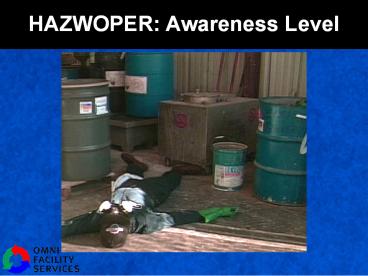HAZWOPER: Awareness Level - PowerPoint PPT Presentation
Title:
HAZWOPER: Awareness Level
Description:
HAZWOPER: Awareness Level – PowerPoint PPT presentation
Number of Views:296
Avg rating:3.0/5.0
Title: HAZWOPER: Awareness Level
1
HAZWOPER Awareness Level
2
Why is Hazardous Waste Dangerous?
- Chemical spills or releases can
- Injure you or your co-workers
- Contaminate drinking water
- Cause a massive evacuation
- Kill innocent bystanders
- You can be exposed without knowing
- Even small spills can cause great damage
3
Ways Chemicals Enter the Body
- Breathe them in through your nose or mouth
- Make contact with your skin or eyes
- Swallow chemicals when eating or drinking
4
Five Levels of HAZWOPER Training
- First responders at the awareness level
- First responders at the operational level
- Hazardous materials technicians
- Hazardous materials specialists
- Incident commander
5
Responsibility of First Responders at the
Awareness Level
- Recognize the hazard
- Evacuate yourself and others
- Notify the proper authorities
- Secure the area
- Help determine the identity of the hazardous
substance
6
Prevent Spills and Releases
- Never leave containers open
- Inspect for damage
- Place in proper containers
- Avoid fires
- Do not overfill
7
Recognize Warning Signs of a Chemical Release
- Liquid on the floor or tables
- Liquid dripping from hazardous containers
- New odor
- Hissing or dripping sound
- Equipment that has lost pressureor flow
8
Evacuate Yourself and Others
- Warn others
- Turn off machines and evacuate
- Stay upwind
- Dont attempt to rescue unless trained
9
Report the Emergency
- Wait until out of hazardous area
- Describe the
- Type of emergency
- Location
- Environmental factors
- Ask for instructions
- Report all fires and spills
10
Secure the Area
- Keep out unauthorized personnel
- Barricade the dangerous area
- Stay out until trained person declares safe
11
Determine the Identity
- Assist emergency response personnel
- Look for NFPA labels
- Blue is toxic
- Red is flammable
- Yellow is reactive
- Numbers 3 or 4 are very hazardous
12
Determine the Identity Material Safety Data
Sheets (MSDS)
- Use MSDS to get information about
- Chemical name
- Physical characteristics
- Fire and explosion data
- Dangerous properties
- Precautions for safe handling
- Reactivity data
13
Ways You Can Help
- Cooperate with emergency personnel
- Gather information about the spill
- Identify the location of
- Injured people
- Potential hazards
- Exit and escape routes
- The nearest fire extinguisher and first aid
equipment
14
If Exposure Occurs
- Inform supervisor
- Describe chemicals
- Flush eyes or skin with water for at least 15
minutes - Seek medical attention if swallowed
15
Summary
- Hazardous waste is dangerous
- Prevent spills
- Recognize a spill or release
- Evacuate yourself and others
- Report the situation
- Secure the area































